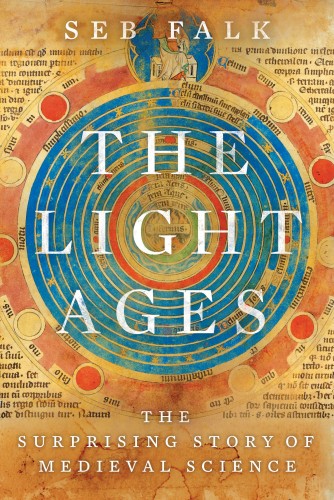
The Light Ages
The Surprising Story of Medieval Science
- اطلاعات
- نقد و بررسی
- دیدگاه کاربران
نقد و بررسی

June 1, 2020
A University Distinguished Professor of Psychology at Northeastern University, Barrett (How Emotions Are Made) gives us Seven and a Half Lessons About the Brain, explaining the origin, structure, and function of that blobby gray mass (50,0000-copy first printing). In This Is the Voice, New Yorker staffer Colapinto, author of the New York Times best-selling As Nature Made Him, explains how this most efficient means of communication defines humans individually and as a whole (75,000-copy first printing). The Dalai Lama's Our Only Home calls on politicians--and encourages the younger generation--to save our planet (50,000-copy first printing). Cambridge historian Falk's The Light Ages shows that the so-called Dark Ages were actually lit up by a keen scientific culture, as universities, eyeglasses, and mechanical clocks got their start. The Kolokotrones University Professor and chair of Global Health and Social Medicine at Harvard University, public health giant Farmer offers an account of the 2014 Ebola crisis that should be especially revealing for us today; as suggested by the title, Fevers, Feuds, and Diamonds, there's sociopolitical context here (20,000-copy first printing). Fung follows up his internationally best-selling The Diabetes Code and The Obesity Code by discussing not just the origin and treatment of cancer but its prevention in The Cancer Code (100,000-copy first printing). Having explored the mental life of octopuses in Other Minds, Godfrey-Smith, a scuba-diving professor of the history and philosophy of science at the University of Sydney, now looks more deeply into animal consciousness in Metazoa. Barnard astrophysicist Levin, a PEN/Bingham Prize-winning novelist and director of sciences at the arts-and-sciences center Pioneer Works, has the wherewithal to provide a Black Hole Survival Guide explaining the cosmos.
Copyright 2020 Library Journal, LLC Used with permission.

June 8, 2020
Falk, historian at Cambridge University, makes an auspicious if occasionally hard-going debut with this look at the “scientific life of an unknown monk” in 14th-century England. The cleric, John Westwyk, is known only through a handful of obscure manuscripts dealing with the creation of astronomical tables and instruments. Nonetheless, Falk skillfully uses Westwyk as a vehicle to explore the nature of medieval science, arriving at a number of somewhat surprising conclusions. He argues that medieval Christianity, rather than blocking intellectual progress, “took support from science–and, in turn, spurred its progress”; that the denizens of English monasteries, far from being isolated, were “profoundly influenced” by an “international scientific fraternity of Jews and Muslims, Italians and Germans”; and that the period’s healthy scientific debates contradict the “stereotype of the Middle Ages as an era of scholastic conformity.” He also explains that the “study of the natural world was a fundamental part of medieval life,” and that despite settling on many incorrect answers, medieval scholars made significant advances. Falk spends a great deal of time demonstrating the complex mathematics used to understand astronomical patterns and may lose some of his audience in the process. Nonetheless, his enthusiastically delivered study will entrance those fascinated by the history of science or the Middle Ages.

September 15, 2020
Expert account of the medieval era's scientific developments. A broadcaster, historian, and lecturer at Cambridge, Falk reminds us that scholars no longer consider the centuries after the fall of Rome as the Dark Ages. Rather, "the medieval reality...is a Light Age of scientific interest and inquiry." The author concentrates on Europe, where literacy was a church monopoly largely confined to monasteries. The greatest of these were wealthy institutions with branches, libraries, and schools whose scholars took part in an international community, which also included Muslims and Jews. Eschewing historical superstars--Roger Bacon makes a few appearances--Falk builds a story around John Westwyk, an obscure 14th-century monk who composed (or most likely copied) manuscripts on astronomical instruments, designed and built others, and traveled widely, making observations along the way. The author makes a convincing case that medieval times produced major advances in technology, mathematics, and education as well as some correct but many more fanciful explanations of natural phenomenon. Important inventions included spectacles, the compass, and Arabic numerals, but almost all of what passed for research confined itself to a single field: astronomy, which had always included astrology and would do so well into the Enlightenment. Fascinated by the heavens, medieval researchers produced precise descriptions of its movements and detected the minuscule variations in the earthly day and year. Much of this was in the service of astrology and the timing of holy days, but it had genuinely practical use in the creation of calendars. Although lacking telescopes, they designed exquisitely complex clocks and astronomical instruments--astrolabes, armillary spheres, equatoriums--that were both impressively accurate and works of art. Falk excels at bringing alive the personalities, theological doctrines, cosmology, and often cutthroat monastery politics of the era, but most readers will prefer to skim the lengthy descriptions of the construction and operation of medieval astronomical devices. An impressive chronicle of human progress.
COPYRIGHT(2020) Kirkus Reviews, ALL RIGHTS RESERVED.




دیدگاه کاربران